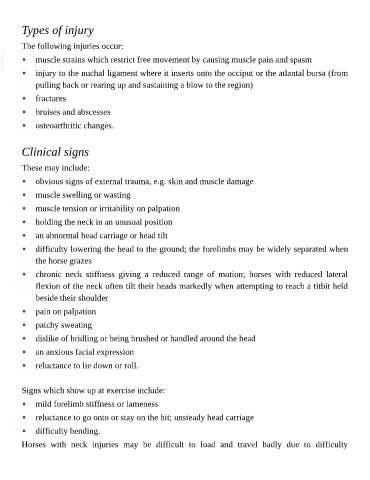Page 530 - The Veterinary Care of the Horse
P. 530
Types of injury
The following injuries occur:
VetBooks.ir • muscle strains which restrict free movement by causing muscle pain and spasm
• injury to the nuchal ligament where it inserts onto the occiput or the atlantal bursa (from
pulling back or rearing up and sustaining a blow to the region)
• fractures
• bruises and abscesses
• osteoarthritic changes.
Clinical signs
These may include:
• obvious signs of external trauma, e.g. skin and muscle damage
• muscle swelling or wasting
• muscle tension or irritability on palpation
• holding the neck in an unusual position
• an abnormal head carriage or head tilt
• difficulty lowering the head to the ground; the forelimbs may be widely separated when
the horse grazes
• chronic neck stiffness giving a reduced range of motion; horses with reduced lateral
flexion of the neck often tilt their heads markedly when attempting to reach a titbit held
beside their shoulder
• pain on palpation
• patchy sweating
• dislike of bridling or being brushed or handled around the head
• an anxious facial expression
• reluctance to lie down or roll.
Signs which show up at exercise include:
• mild forelimb stiffness or lameness
• reluctance to go onto or stay on the bit; unsteady head carriage
• difficulty bending.
Horses with neck injuries may be difficult to load and travel badly due to difficulty

